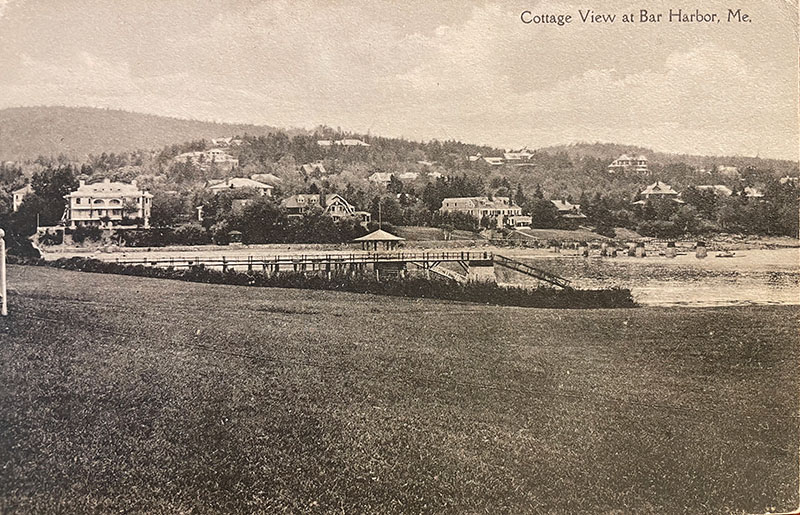A Bar Harbor View, 1870–1910
by Astrid Tvetenstrand
With the support of a Decorative Arts Trust Research Grant, I visited Portland, ME, and conducted research for my PhD dissertation in American & New England Studies at Boston University. Navigating the parameters surrounding the COVID-19 pandemic was challenging, but thanks to the Trust’s understanding and support, I completed research at the Portland Museum of Art and the Maine Historical Society.
My dissertation investigates the value of views. I ascertain how they are constructed by examining images of landscape in varying mediums. At the Portland Museum of Art, I examined a collection of late 19th-century landscape paintings, many of which were focused on Maine’s alluring coast. At the Maine Historical Society, I had the privilege of studying turn-of-the-century postcards that provided much-needed context about the visual, material, and economic landscape of Bar Harbor and the surrounding region.
American landscape painters have drawn inspiration from Mount Desert Island over the past two centuries. In the mid-1800s, artists like Frederic Edwin Church, Thomas Cole, and Fitz Henry Lane visited the island and painted its picturesque and unique features. Their paintings encouraged others to visit this seemingly remote place, and affluent residents of urban spaces such as Boston and New York City eagerly escaped the summer conditions of city life. In so doing, a culture of elite tourism and summer living was born in Bar Harbor, and wealthy individuals built lavish summer homes and vacationed in this both geographically and financially exclusive locale. A 1910 postcard, Malvern Cottage, Kebo Street, Bar Harbor, Maine (figure 1), shows a row of large houses, seemingly positioned to look towards something special. Some built in the popular shingle style, the homes’ windows provide a special topic to think about what each property owner was viewing. We often think about the interiors, how spaces are decorated, and what we cannot see inside. In thinking about what these homes are positioned towards, we are also thinking about strategically placed architecture, no less focused on aesthetics than the interiors of these houses.
Postcards from the early 20th century show how the once-wild and admired landscape of Bar Harbor, ever so alluring to Church and others, changed significantly because of home building. Yet, one characteristic remains prevalent in all these representations of landscape: the connection between people, houses, space, and viewsheds. Without the latter, the seasonal homes under investigation would lose value. Each postcard examined at the Maine Historical Society expresses just how dependent one was upon the other.
A 1919 postcard, Cottage View at Bar Harbor, Me (figure 2), further highlights how each home was connected to its corresponding views. With some space separating each house, providing the desired privacy and emphasizing the exclusive character of the island, we are also privy to the connection between the landscape and the corresponding properties. Homes pop up from dense trees, and the windows of these places pop out over the tree line, positioned to the Atlantic Ocean. The effects of 19th-century landscape painting continued to influence this place well into the 20th century. The desirable characteristics of each 19th-century image enticed people to build these homes and this postcard shows how each property was connected to the physical and material characteristics emphasized by painters of the past.
A 1906 postcard, Bar Harbor from Great Hill, Mt. Desert Island, ME (figure 3), positions the viewer at the top of a hill looking outward towards Bald Porcupine Island. Located in Frenchman Bay between Mount Desert Island and Schoondic Point, this provides the breakwater that makes Bar Harbor a safe port. Looking downward at the town, it reveals the high concentration of coastal buildings at this early date. The correspondence on the postcard states “a beautiful place,” and each postcard highlights just that.
Aesthetics were not just tied to inside the home. Rather, they were a holistic component in a larger experience of life on Mount Desert Island. Possessing an immaterial thing, a view, elevated the beauty of the properties and enhanced their visual and material value. The Trust’s Research Grant has allowed me to think critically about images, examine their circulation, and think about why cultural and physical landscapes were shaped with preference to aesthetics, the picturesque, and nature. In so doing, the outdoors has ultimately proven itself to be a material space that people at the turn of the century were interested in possessing, and these postcards are evidence of the commercialization of landscape that occurred throughout the 19th and into the 20th centuries.
Astrid Tvetenstrand is a PhD Candidate in American & New England Studies at Boston University and is currently the Social History Fellow at the Preservation Society of Newport County.
About The Decorative Arts Trust Bulletin
Formerly known as the "blog,” the Bulletin features new research and scholarship, travelogues, book reviews, and museum and gallery exhibitions. The Bulletin complements The Magazine of the Decorative Arts Trust, our biannual members publication.
Click Images to Enlarge
Did you know that clicking on the images in Bulletin posts will allow you to get a closer look? Simply click on an image, and a larger version will open in a pop-up window.










